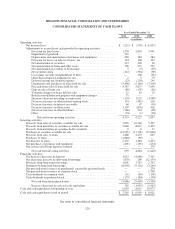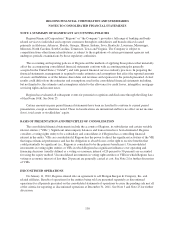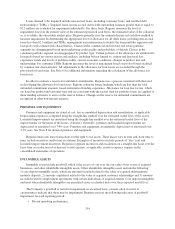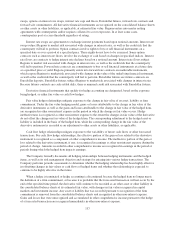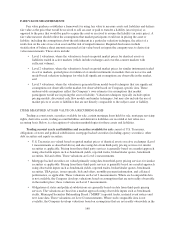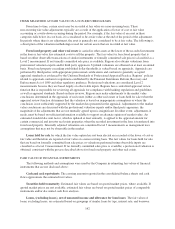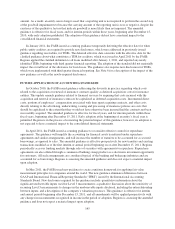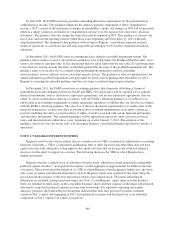Regions Bank 2011 Annual Report Download - page 161
Download and view the complete annual report
Please find page 161 of the 2011 Regions Bank annual report below. You can navigate through the pages in the report by either clicking on the pages listed below, or by using the keyword search tool below to find specific information within the annual report.swaps, options on interest rate swaps, interest rate caps and floors, Eurodollar futures, forward rate contracts and
forward sale commitments. All derivative financial instruments are recognized on the consolidated balance sheets
as other assets or other liabilities, as applicable, at estimated fair value. Regions enters into master netting
agreements with counterparties and/or requires collateral to cover exposures. In at least some cases,
counterparties post at a zero threshold regardless of rating.
Interest rate swaps are agreements to exchange interest payments based upon notional amounts. Interest rate
swaps subject Regions to market risk associated with changes in interest rates, as well as the credit risk that the
counterparty will fail to perform. Option contracts involve rights to buy or sell financial instruments on a
specified date or over a period at a specified price. These rights do not have to be exercised. Some option
contracts such as interest rate floors, involve the exchange of cash based on changes in specified indices. Interest
rate floors are contracts to hedge interest rate declines based on a notional amount. Interest rate floors subject
Regions to market risk associated with changes in interest rates, as well as the credit risk that the counterparty
will fail to perform. Forward rate contracts are commitments to buy or sell financial instruments at a future date
at a specified price or yield. Regions primarily enters into forward rate contracts on marketable instruments,
which expose Regions to market risk associated with changes in the value of the underlying financial instrument,
as well as the credit risk that the counterparty will fail to perform. Eurodollar futures are futures contracts on
Eurodollar deposits. Eurodollar futures subject Regions to market risk associated with changes in interest rates.
Because futures contracts are cash settled daily, there is minimal credit risk associated with Eurodollar futures.
Derivative financial instruments that qualify for hedge accounting are designated, based on the exposure
being hedged, as either fair value or cash flow hedges.
Fair value hedge relationships mitigate exposure to the change in fair value of an asset, liability or firm
commitment. Under the fair value hedging model, gains or losses attributable to the change in fair value of the
derivative instrument, as well as the gains and losses attributable to the change in fair value of the hedged item,
are recognized in other non-interest expense in the period in which the change in fair value occurs. Hedge
ineffectiveness is recognized as other non-interest expense to the extent the changes in fair value of the derivative
do not offset the changes in fair value of the hedged item. The corresponding adjustment to the hedged asset or
liability is included in the basis of the hedged item, while the corresponding change in the fair value of the
derivative instrument is recorded as an adjustment to other assets or other liabilities, as applicable.
Cash flow hedge relationships mitigate exposure to the variability of future cash flows or other forecasted
transactions. For cash flow hedge relationships, the effective portion of the gain or loss related to the derivative
instrument is recognized as a component of other comprehensive income. The ineffective portion of the gain or
loss related to the derivative instrument, if any, is recognized in earnings as other non-interest expense during the
period of change. Amounts recorded in other comprehensive income are recognized in earnings in the period or
periods during which the hedged item impacts earnings.
The Company formally documents all hedging relationships between hedging instruments and the hedged
items, as well as its risk management objective and strategy for entering into various hedge transactions. The
Company performs periodic assessments to determine whether the hedging relationship has been highly effective
in offsetting changes in fair values or cash flows of hedged items and whether the relationship is expected to
continue to be highly effective in the future.
When a hedge is terminated or hedge accounting is discontinued because the hedged item no longer meets
the definition of a firm commitment, or because it is probable that the forecasted transaction will not occur by the
end of the specified time period, the derivative will continue to be recorded as an other asset or other liability in
the consolidated balance sheets at its estimated fair value, with changes in fair value recognized in capital
markets and investment income. Any asset or liability that was recorded pursuant to recognition of the firm
commitment is removed from the consolidated balance sheets and recognized in other non-interest expense.
Gains and losses that were unrecognized and accumulated in other comprehensive income pursuant to the hedge
of a forecasted transaction are recognized immediately in other non-interest expense.
137




